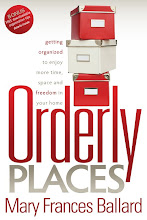Photo courtesy of goodhouskeeping.com
This month brings us the
back-to-school events, the end of summer sales and final trips to the beach and
other vacation destinations. Planning for fall activities is a good idea,
too. After a few tips for making the
most of the back to school sales, we will concentrate on organizing the toys
and electronics.
Many states have a weekend of freedom from sales tax to help with school supplies. Many office and stationery supplies are covered, too. These stores will identify covered items for you. In
Most stores have increased their inventory of school and office supplies. You can find a better selection and better prices this month. Make a list and try to find those things you need while there are good choices. Plan ahead for consumable items like printer paper, notepads, etc. Be sure you have room to store these items. Clean out items that are no longer useful or in disrepair. Organizing your files is a great indoor activity when the weather is too hot for outside work. For children, check the supply list created by the specific school or teacher.
Think ahead in purchasing
children’s clothing. My oldest child
grew 3” the first two months of his 9th grade year. The clothes I purchased
early in August to get the best selection were too small in October. (This was
before long baggie pants were acceptable.)
If you plan on having a yard sale in the fall, begin planning now. Start gathering items that you need to move on, clean and price them. Young children have probably outgrown last year’s school attire. Take an inventory to see what you can sell or donate now. As colder weather and winter approach, you may need to take another look at heavier clothing to see what can be eliminated.
Go to Craig’s list or EBay to determine a reasonable price for selling your items. In fact, you may want to put some of the items up for sale there now so they won’t take up storage space in your home. If you want to join with others in a sale, pick a date now that is good for everyone.
If you plan on having a yard sale in the fall, begin planning now. Start gathering items that you need to move on, clean and price them. Young children have probably outgrown last year’s school attire. Take an inventory to see what you can sell or donate now. As colder weather and winter approach, you may need to take another look at heavier clothing to see what can be eliminated.
Go to Craig’s list or EBay to determine a reasonable price for selling your items. In fact, you may want to put some of the items up for sale there now so they won’t take up storage space in your home. If you want to join with others in a sale, pick a date now that is good for everyone.
Tips for Organizing Toys
- Children learn from their toys but there should be limits on how many they own and how many they can have out at one time. Decide what that will be ahead of time and stick to it. Encourage relatives and friends to give clutter free gifts to your children.
- Toys should be more difficult to get out than put away. Books that are stored upright on a shelf are easy to pull out and more difficult to put back in order. A better choice would be a dishpan, bucket or basket that makes the child look for the book he wants but will be easy for him to drop it back in when he is done with it.
- Depending on the age of the child, most toys should be kept in open bins arranged in cubes or shelves and labeled so that clean up easy. Picture labels can be used for toddlers and large word labels for children learning to read.
- Some special toys or games can be stored on a higher shelf where only a parent can reach it as a reward or incentive for cooperation, responsibility, etc.
- Hanging pockets and plastic stacking drawers are good choices for small toys such as doll clothes, matchbox cars or train pieces.
- Puzzles should be kept in their original box. The corners may need to be reinforced with clear tape. Another choice is zip lock bags with the picture included. Color code the backs of the pieces for each puzzle with markers or crayons. Then the correct pieces can be returned to the proper box if more than one puzzle is out at a time.
- Other storage options are over the window shelving to display some collectible toys, corner nets to hold stuffed animals and totes on wheels to transport toys that can be taken to other rooms temporarily.
Tips for Organizing Electronics
- Arrange electronic items such as televisions, CD and DVD players and video games in one area so the wires and cables can be contained together.
- Label each end of cables and wires related to the computer and other electronic equipment. It will save much time in connecting or reconnecting
- Use wire baskets that can be mounted under shelves or cable ties to contain wires.
- Purge videos, CDs and DVDs that are no longer used. Sell or donate them to a local charity, nursing home or hospital. If you want to locate one again they can be rented or borrowed from local libraries.
- Renting or borrowing movies and games is an excellent organizational choice and sets a good example for your children in managing finances and spaces.
- Store CDs and DVDs in their case vertically on shallow shelves or if space is limited, they can be removed from the case and placed in notebooks or cases with plastic sleeves. Sort and arrange by category.
- Videos can be stored vertically on shelves or in shoe box type containers. Do not stack flat as accessing those on the bottom is more difficult.
- Remotes and game joysticks should be contained in a basket, decorative box or container designed specifically for them. Keep them within easy reach of the chair or sofa.
- Place a table or shelf near every seating area. Large coffee tables can take the place of several small end tables. Choose one with storage shelves, cabinet doors or drawers. Provide an area for playing with toys if you will allow that activity. A lower cabinet can be used to store those items or they can be taken back to the bedroom in a tote box or rolling crate.

